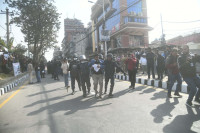Opinion
Growth essentials
The recently released foreign trade figures of the first nine months of the fiscal year 2074/75 depicts Nepal’s ballooning trade deficit. The ever increasing trade deficit could have a far reaching impact on the macroeconomic fundamentals of a country.
Mina Aryal
The recently released foreign trade figures of the first nine months of the fiscal year 2074/75 depicts Nepal’s ballooning trade deficit. The ever increasing trade deficit could have a far reaching impact on the macroeconomic fundamentals of a country. Continuous enhancement of productive, competitive and overall supply-side capacity of a country is important to ensure the trade gains in today’s globalised, interdependent and competitive world. Implementing a multipronged approach in a coordinated way and strategic intervention in some focused areas such as institution, infrastructure and agriculture is instrumental in trimming down the ever-increasing trade deficit of Nepal.
Economic globalisation has substantially increased the interdependency among countries in general, and has demanded enhanced productive and competitive capacity in all sectors. Such developments could have both positive and negative effects. An advantage could be that countries could specialise in the areas in which it deserves the comparative advantage and competitive strengths. On the downside, countries may further be marginalised due to its weak competitive capacity.
Not up to the par
Nepal’s export performance is not up to the par. The data of the first 9 months of fiscal year (FY) 2074/75, shared by the Trade and Export Promotion Centre (TEPC) depicts that out of total trade of Rs934.5 million, exports only account for 6.4 percent. This means there is a trade deficit of Rs874.88 million. The export-import ratio too is 1:14.7. The export-import ratios were 1:13.1 and 1:10.4 during same period of FY 2073/74 and 2072/73 respectively. Economists view that the huge trade deficit could invite macroeconomic instability, which will have a negative impact on the country’s balance of payments. Moreover, the imports are mostly related to unproductive sectors such as vehicles, gold, daily consumable goods, agricultural products, medicines, entertainment and luxury goods.
Underlying issues and impacts
Massive subsidies, followed by mass production, automation, mechanisation, and massive investment in the research and development (R&D) in developed and developing countries have substantially helped increase agricultural production. This has resulted in lowered unit costs of agricultural products. Excessive imports have turned many countries, including Nepal, into net food importing countries. Similarly, the manufacturing sectors in several small countries are badly affected due to the lack of means to mass produce. It is striking that in just a few years’ time, the contribution of the manufacturing sector in Nepal’s Gross Domestic Product (GDP) has dropped to about 5 percent from more than 10 percent.
Nepal’s heavy reliance on remittance, which currently accounts for one-third of the country’s GDP, might develop a case of the ‘Dutch Disease’—high dependency on one source of foreign currency which is unsustainable—according to some economists. Skyrocketing imports, sluggish exports and low disbursement of foreign aid, along with a decrease in the inflow of remittances, could pose a serious challenge to macroeconomic stability including balance of payments.
Institutions and infrastructure
It is important to mention that the World Economic Forum’s Global Competitiveness Report, based on 12 indicators of competitiveness, provides insight into the drivers of a country’s productivity and prosperity. Among the 12 indices, the first pillar is institution and the second is infrastructure.
Institutions are the building blocks of overall economic growth, development and prosperity. Public institutions’ vision, mission, goals, strategy, policy, legal and administrative procedure matter significantly in leveraging resource mobilisation, improving transparency, accountability along with enhancing effectiveness and efficiency of those institutions.
Studies show that massive investment in planned infrastructure development proves to be a prudent strategy for faster economic development and integration in the global trading system. Physical infrastructures like roads, airports, ports etc. are important. But equally important are information and communication technology (ICT) infrastructure such as computers, broadband, access to internet etc. Enhanced supply of reliable electricity is a key factor for improved output in the industrial sector. Similarly, extensive and efficient infrastructure is critical for ensuring effective functioning of the economy—especially in determining production, trade and investment decisions.
Similarly, agriculture plays a crucial role in any economy. The agricultural sector of Nepal needs structural transformation and diversification. The sector is largely dependent on subsistence farming where involvement of about two-thirds of the population contributes to only one-third of the GDP. Farming should be carried out scientifically and according to the competitive and comparative advantage of three geographical regions, the Tarai, the hills and the mountains, to increase the production and productivity. A number of tools such as contract farming, cooperative farming, leasing, extension services, back ward and forward linkage of production process, systemic mechanism to link training, finance and market etc. could be applied to enhance higher-level productivity in agriculture.
Achieving macroeconomic stability requires multipronged strategies in a coordinated way in several areas at the national, provincial and local levels. The implementation of trade policies, export and integration strategies, modernisation and institutionalising business perspectives in agriculture, building physical and digital infrastructures, institutional strengthening and strengthening manufacturing sector are essential. Similarly, value chain development and participating in areas of our competitive advantage, are equally important.
To conclude, strengthening the public institution, building quality and reliable infrastructures and structural transformation in agriculture, among others, are highly imperative for enhancing supply-side, job creation, export promotion as well as for achieving Nepal’s Sustainable Development Goals.
Aryal is the Deputy Permanent Representative (Commerce) at the Permanent Mission of Nepal to Geneva




 18.12°C Kathmandu
18.12°C Kathmandu










